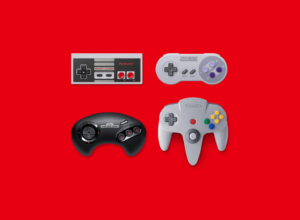Have Oculus and their many competitors left it too late and too expensive for virtual reality to become anything more than a passing fad?
After a couple of years of hype and iterative development kits, Oculus have finally revealed the price-point for the first wave of ‘proper’ virtual reality devices to go to mass market consumption: £500. Yes, for the price of a kidney (you only need one, don’t you?), you can finally jump on the Rift hype-wagon and enjoy the benefits of the legendary virtual reality experience.
Ever since time-immemorial, virtual reality has been the vision of the future, with a multitude of classic novels, films and TV shows developing entire fictions around the concept of VR; a litany of stories that envision the technology eliciting the blissed-out Nirvana of a perfect holiday, or producing the dystopian horrors of a humanity bound within VR slavery. Even the mighty Red Dwarf has ‘Better than Life’; a VR system so consuming it kills you.
More relevantly, VR in videogaming has always been a topic of fevered excitement and readily assumed the next great evolutionary leap for the medium; one that will permit us to dive through our TV screens and become encased within new, fantastical and wondrous worlds. Even the mundanity of the everyday so oft appropriated by video games (be it driving a car or walking down a street), will been enriched and enlivened by VR: could you image Grand Theft Auto 5 or Forza 7 in VR? The anticipation of such experiences is sufficiently overwhelming as to make the average gamer feel wobbly at the knees and in need of a good lie down.
However, if the vitriol towards the price of the Rift is a barometer of anything, VR might be facing a suddenly antagonistic audience upon its birth. And even beyond the embittered disgruntlement of fiscal expense, it could be suggested that VR has more problematic issues to overcome if it wants to be anything more than an interesting but failed footnote in gaming history, or simply a curio piece for the tech-savvy.
When Oculus first announced the Rift sometime in 2012, there was nothing else like it. Sure, people had dabbled in VR during the 90’s and, if you had been lucky enough, you might have tried one of the massive, bulky headsets in some London arcade, but the whole scene had been assumed dead in the water for over a decade. And, unlike the clunky builds and low-polygonal abstract approximations of life that the aforementioned devices or the peculiar Lawnmower Man movies demonstrated, the Rift appeared as though home-friendly and working with graphically resplendent games. This was exciting: the future was finally here! So exciting, in fact, the Rift project was rapidly crowd-funded and the mighty Jon Carmack of id Software left the company he had helped co-found to jump on-board the Oculus train.
However, Oculus, in many ways, showed their hand too soon. From VR being a distant memory akin to a pleasant but failed dream, the tech suddenly burst back to life and the race for VR was triggered. Oculus rapidly went from being the only entity waving the VR flag to being one of many bodies falling over themselves to be the first to the finish line with a consumer-level product. Sony birthed the Morpheus, Valve and HTC conjured up their own headset, and any trade show of note was awash with start-ups doing their own VR tech. Oculus themselves released two developments kits, the DK1 and DK2, for those interested in experiencing the future in a truncated, hog-tied form.
A by-product of all this is that we have now been in the throes of VR hype and (it could be suggested) over-stimulated by the wonders of it all for an excess of three years. The problem with over-stimulation is (as any sugar-rush toddler on a come-down will attest) you eventually get exhausted and just want the excitement to stop so you can recoup and recover. But, as consumers, we haven’t been given that grace period from VR. Even though many have yet to get their hands on the new generation, the technology feels like it’s been around forever already; a known entity that we have had our full of. Clearly, this could be problematic for Oculus and its competitors: burning-out your audience before you even release your product is not the greatest plan ever conceived, and VR as a whole now has to contend with this over-familiarity and over-exposure rubbing away the glossy thrills of the new and unexpected.
Then there is the issue of ease-of-use (or lack thereof). As someone fortunate enough to have delved into the supposed pleasures of VR with both iterations of the Rift development kits, I have donned these heavy head-burdens and experienced the joys of disorientation, nausea and the legitimately fascinating sense of immersion these kits provided. But I have always unsheathed my bonce with relative speed and have not been particularly interested in re-engaging with the tech after that initial, dizzying thrill. Why? A procession of personal gripes: the headsets are too heavy; being within one elicits the feeling of being trapped; the simultaneous awareness of two realities – the one my eyes see, and the other my body senses – that I find both unnerving and discombobulating.
Furthermore, I dislike swiping my hands through the air to interact with something virtual, only to encounter a sharp, cracking pain as said appendage makes meaty contact with something real. And when you take the headset off, there is a terrible moment of confusion as you find yourself (due to unknowingly rotating your body) not staring at the wall or piece of furniture you had been facing upon entry into virtual reality, but an entirely different wall or piece of furniture: it’s akin to waking up in the dark and forgetting where you are.
Then there is the bulk of the thing. Certainly, the consumer-level products are more refined in shape, but let us not kid ourselves, these devices are not exactly the streamlined ergonomics we have come to expect from our electronic gadgets; the first-wave of VR headsets are to mobile phones what the massive, 80s-yuppie bricks are to the pocket-sized whispers of a thing we all regularly slip unthinkingly into trouser pockets. And let us not even start on the tangle of wires, additional peripherals, room-space and the high-end PC required just to get the thing running.
The counter-argument to the above is that, just as with phones, VR technology will become increasingly refined, and with refinement so to the headsets will become smaller, lighter and more manageable; the wires will become wireless; and work-arounds for room-space issues will be developed (already, many VR experiences now see the player in a seated positon, as opposed to the initial flurry that had players standing and, by virtue, instinctively moving their bodies around). And all of this is potentially true and correct, but it is within this time-delay that augment reality comes to play.
Since Oculus showed the Rift to the non-expecting public, augmented reality, that incredible tech many first saw imagined in Minority Report, has suddenly become a very real virtual reality. At last year’s E3, Microsoft single-handledly blew everyone’s collective minds with their demonstration of HoloLens, and a number of tech demo videos have done the rounds on YouTube illustrating potential uses of AR: car windscreens with virtual map overlays; electronic equipment with virtual guides mapped upon them; the moon surface in your living room with points of interested virtually imposed; and, most importantly, video games that actually play out in the real world! Magic Leap, a start-up AR company, have many impressive examples to drool over, with zombies bursting out from real-world walls, and guns and power-ups scattered around office floors for you to pick up and blast virtual brains. Sure, much of this is a projection of what AR can achieve, but if reports of those who have actually used these devices are to be believed, the technology is already capable of performing these feats and performing them well.
And AR overcomes many of the issues that burden VR: the devices are reportedly light-weight and easy to wear; you are still aware of your real environment and can freely move; wires and additional gear are not required; and the whole endeavour appears to be easy-to-use and effortlessly slips into our existing use of technology. As the nomenclature suggests, AR augments our experiences of, and interactions with, both the real-world and our existing devices, unlike VR which demands use as an insular and separate experience. Which sounds the most appealing, especially to a broad, mass audience? The device that forces you to lock yourself away, all wired up and removed from reality, or the device that works with you and supplements your daily tech use with additional and potentially beneficial graphical overlays?
Invariably, both technologies at launch will be bulky and unwieldy versions of what they have the potential to become, but AR just seems to have the edge and the potential to break through that glass-ceiling and become a widely adopted piece of technology. VR, however good and fun it maybe, looks set to be the also-ran: an interesting and beloved piece of curio-tech for the savvy to engage with but one that will remain broadly ignored by the masses.
What do you think?






